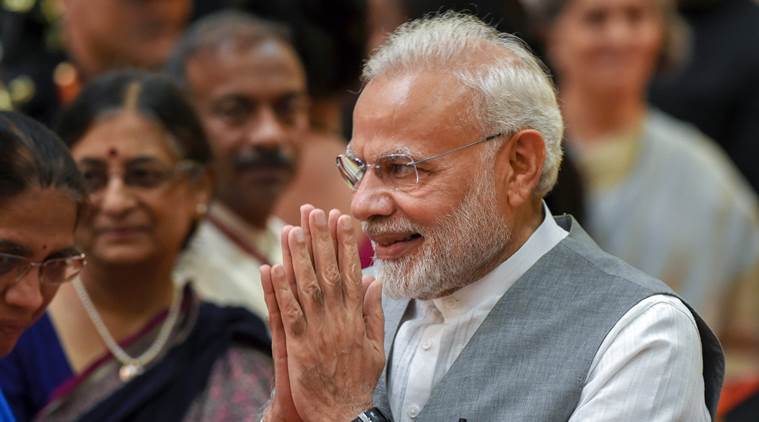A big ask in election year
The consequence is that the government revenue has become oil-dependent, government is loath to give up easy revenues, and there is mounting anger among the people as prices of petrol, diesel and LPG soar every day.

Undeniably, the government reaped a bonanza in the early years.” (PTI Photo/Atul Yadav) (PTI8_15_2018_000298A)
Numbers yo-yo up and down from month to month. Hence, economists and analysts always look for a trend, over a quarter or half year, before reaching any conclusion. After looking at data over the medium term, it appears that the foundations of macroeconomic stability of the Indian economy are becoming weaker. The trend may still be reversed and, as a concerned citizen, I hope it will be.
Let us look at the sources of the vulnerability that is causing anxiety. Firstly, the price of crude oil. Undeniably, the government reaped a bonanza in the early years. In June 2014, just after the NDA government assumed office, the price of the Indian basket of crude oil was USD 109 per barrel. From July onwards, the price started falling, reaching USD 46.6 in January 2015. From January 2015 to October 2017 (except May and June 2015), the price never crossed USD 60. Those were unbelievably low prices. This factor alone contributed hugely to improving the macroeconomic indicators. Had the prices of petrol, diesel and LPG been reduced to reflect the decline in the price of crude oil, consumers would have gained substantially. The government would have nothing of that and increased taxes on petroleum products to deprive households and businesses of the gains of lower prices. The consequence is that the government revenue has become oil-dependent, government is loath to give up easy revenues, and there is mounting anger among the people as prices of petrol, diesel and LPG soar every day.
Crude oil spoils party
In my estimate (Indian Express, January 14, 2016) the ‘windfall’ for the 12-month period (December 2014 to November 2015) was about Rs 1,40,000 crore comprised of expenditure savings and additional revenue. In the two subsequent years (2016 and 2017), the ‘windfall’ would have been equally large. In spite of this, the government has not been able to adhere to the fiscal consolidation roadmap. In the four years of the NDA government, the fiscal deficit has been 4.1, 3.9, 3.5 and 3.5 per cent and the estimate for 2018-19 is 3.3 per cent. I believe that the estimate of 3.3 per cent is based on the assumption that the price of crude oil will remain below USD 70. That seems unlikely and Brent price is close to USD 80. Hence, the first point of stress is the fiscal deficit.
Secondly, exports are lower than imports every month, leaving a deficit on the trade account, but that is not unusual. However, the growth rate of exports still lags behind the growth rate of imports, and that was remediable. Nothing worthwhile was done and merchandise exports remained stagnant for four years at below USD 310 billion. The net effect is that the current account deficit (CAD) has widened and is expected to rise from 1.87 per cent in 2017-18 to 2.5-3 per cent at the end of 2018-19. That is the second point of stress.
Thirdly, the emerging markets party seems to be over and global investors seem to be rebalancing their portfolios. As US interest rates are hardening, Foreign Portfolio Investors (FPIs) have been selling off, leading to net outflows from India. This year, the net outflows by FPIs till date, including equity, debt and hybrid, have been Rs 47,891 crore. It is too early to call, but it is likely that 2018-19 will see the biggest outflow since 2008-09 (the year of the international financial crisis).
Rupee dips, yield rises
Fourthly, because of these factors, the rupee is becoming weaker. Against the dollar, its conversion rate has fallen by 12.65 percent in 2018. Four days ago, the government put out a statement that “government and RBI will do everything to ensure that rupee does not slide to unreasonable levels”. Such assurances tend to fall flat on investors and analysts who are focused on critical numbers — FD, CAD, bond prices, return on investment net of inflation, etc — than on reassuring words. Despite the nudge to “do everything to ensure…”, the only thing that the RBI can do to arrest the depreciation is to sell dollars, but there are limits to such intervention.
Finally, in the last one year, the yield on the 10-year government bond has risen by 1.5 per cent. As I write, the yield has touched 8.13 per cent. The rate is a measure of the perceived risk of investing in India. Together with the depreciating rupee, the rate suggests that the markets are concerned about macroeconomic stability in the country.
Don’t lose focus
The last word may be said by the RBI in the monetary policy statement due in October. If the RBI hikes the repo rate again and changes its stance to withdrawal of accommodation, it will be because the RBI too shares the concerns about macroeconomic stability.
None of the above is unprecedented. We faced a similar situation in 1997, 2008 and 2013, albeit for different reasons. In such a situation, a small rise in the Sensex or a dip in the bond yield on a given day, or a ‘steady’ IIP, or a marginal fall in CPI should not be a cause for celebration. That is the yo-yo of numbers that I referred to at the beginning! Instead, the government should focus on unclogging and boosting investments, increasing bank credit (especially to industry) and keeping a tight control on expenditure. Is that a big ask?
For all the latest Opinion News, download Indian Express App
More From P Chidambaram
- Across the Aisle: Black to white magicRBI had done no study or preparatory work; yet the Central Board of RBI hurriedly met on November 8, without an agenda and without a…
- Across the Aisle: Jobs- The make or break issueThe reality is that a loan of Rs 47,268 is not sufficient to create a job. That amount may be enough to buy some tools…
- Across the Aisle: Emulate, do not envyThe first year was promising and the second year too started well. The first major blunder was demonetisation on November 8, 2016. This was followed…







































No hay comentarios:
Publicar un comentario